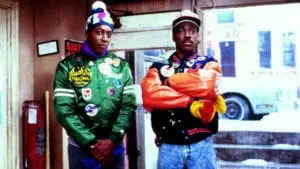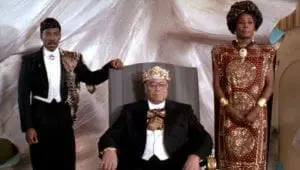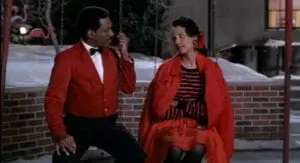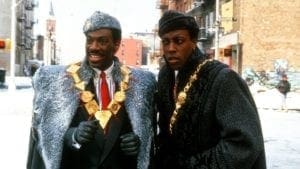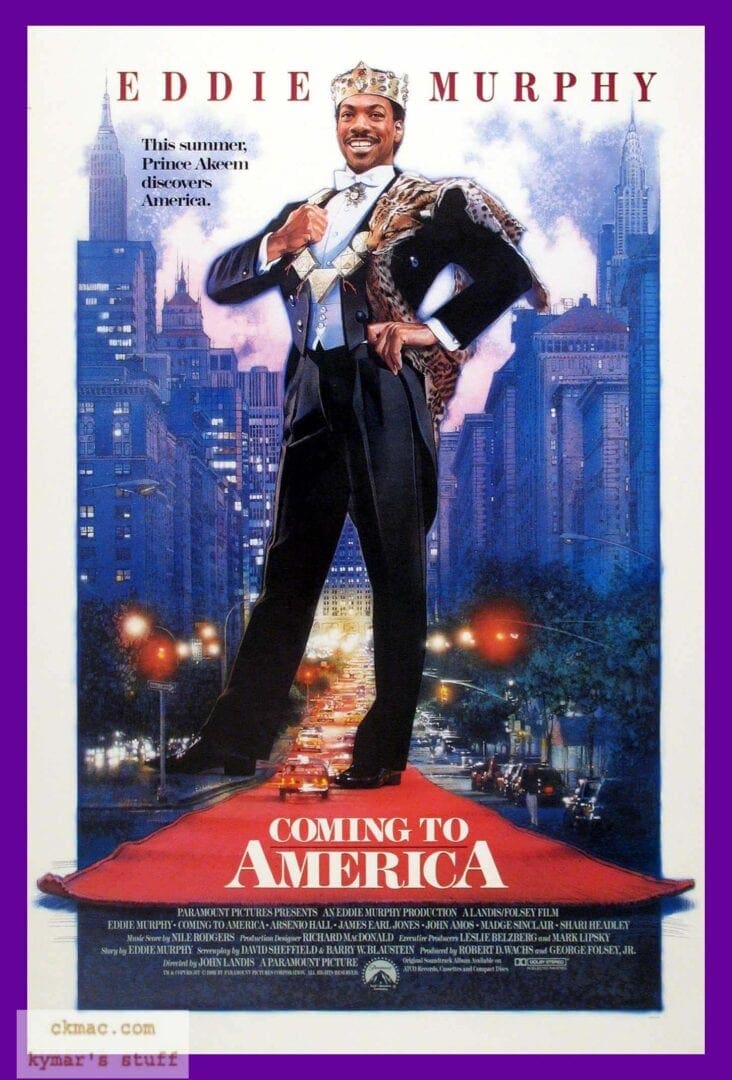Coming to America
(1988)
starring Eddie Murphy and Arsenio Hall
African Prince Akeem (Eddie Murphy) is surrounded by beautiful women who cater to his every whim, including the one he is betrothed to marry. He travels to New York City with his steadfast companion Semmi (Arsenio Hall) in hopes of finding and falling in love with a woman who challenges him – and loves him for who he is as a person rather than his wealth and royal position.
Why it’s rad:
Coming to America is a film is “the most beloved black comedy of all time,” according to theGrio. It’s a film that’s retained its cultural relevance and is noted for its elaborate costumes and phenomenal dance sequence. It was Eddie Murphy’s first romantic comedy, but more importantly, it’s the first film where he played multiple characters – something that would become a hallmark. It elevated Murphy from movie star to mega star. Perhaps its most important contribution was that it was proof that a "black" movie could be a mainstream, box office smash.
Why it’s So '80s:
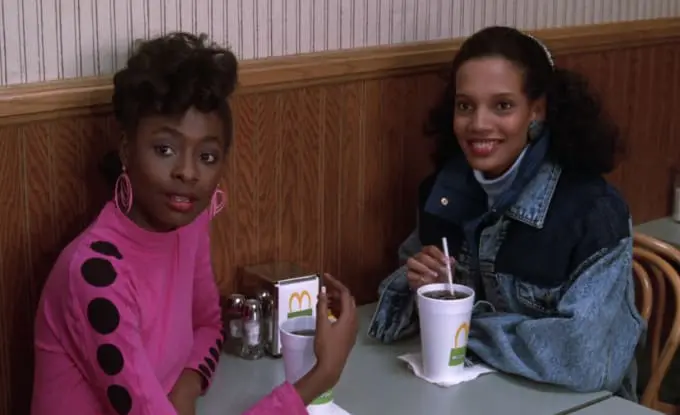
The 1980s were all about the perm, and SoulGlo is a fictional version of Jheri Curl, a permed hairstyle popular in the black community during the decade. The curl activator gave users a glossy, soft, loose curls but, as depicted in the film, could leave a greasy residue behind.
Akeem is trying to fit in, and those acid wash jeans were all the rage in the late ‘80s. Lisa and Patrice reflect some serious ‘80s fashion as well: Patrice wears bright, neon clothes; Lisa and Patrice show off denim jackets and chunky, colorful dangling earrings.
The nudity is, well, so ‘80s. Before the internet, young men looked to films as a socially acceptable way to catch an eyeful of topless women.
What’s your damage?
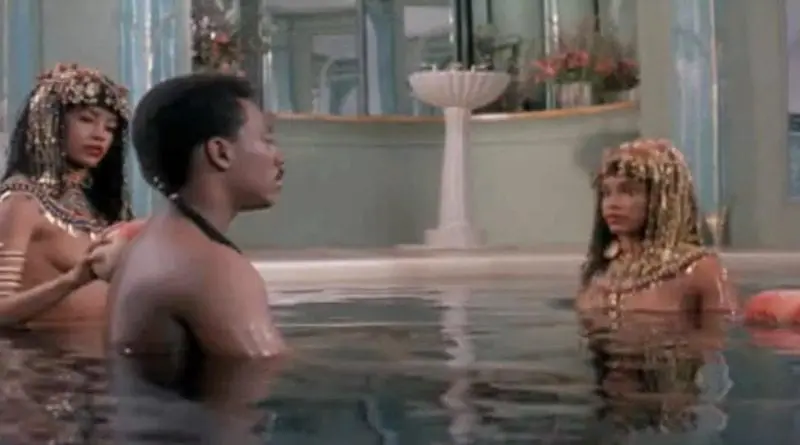
Coming to America is hilarious, sure, but is typical of the chauvinistic messages in films of the ‘80s. The film infers:
· Women exist to serve men.
· Women are only after a man’s money and power.
· A woman’s needs are irrelevant.
· Women are only sexual beings EXCEPT….
· …the woman you marry, who should be virginal.
Prince Akeem is surrounded by women whose lives are dedicated to him, in every way: royal butt wipers, royal bathers/penis cleaners, etc. These female servants are depicted as modern geishas, who just see these sort of sexual or demeaning activities no different than bringing him tea. Akeem doesn’t engage these servants in conversation, but willingly partakes in the services they offer.
His betrothed, Imani Izzi, has grown up studying Akeem’s every preference so she can be an ideal companion. When he interviews her about her likes and dislikes, she defers to him because she spent 21 years of her life learning that was the correct answer. Having only spoken to her for less than two minutes, Akeem leaves her at the altar with no regard to her feelings. The future king treats her like a dog – literally commanding her bark like a dog -- and not giving her the permission to stop. Akeem talks about wanting to find a woman with an opinion, but he doesn’t offer any of the women the real opportunity to do just that. The idea that Akeem is a sensitive romantic doesn’t hold water – he doesn’t treat the women in his world with respect.
When he discovers Lisa McDowell, he falls for a woman who is one of the world’s most beautiful women (actress Shari Headley had just won Ford Modeling Agency’s Supermodel of the Year contest), a virginal woman who lives at home (Headley also lived at home and implied to People Magazine she was a virgin), who takes care of her family by balancing the books for the family business, and who gives speeches about how “the children are our future.” A future homemaker, for sure. The message: girls – this is what a wife looks like.
Akeem doesn’t care that Lisa has a long-term boyfriend, he works his way into her life by lying about his identity. Patrice, Lisa’s sister who is available, is interested in Akeem. Patrice is sexually forward, and the film portrays that as an unappealing quality – a joke. So, even though this film is about Akeem finding a woman who challenges him and has an opinion, the film still perpetuates the notion that a woman’s value is in her appeal to a man – and that women who are sexually available are to be “had,” but are not relationship material.
Furthermore, Semmi lies to Patrice and tells her he is the Prince of Zamunda. She fools around with him, but, ha-ha, the joke is on her! The idea is: that’s what you get for being a gold digger/starf***er! Sadly, this is a comedy trope of the ‘80s: trick a girl into having sex by pretending to be someone she is interested in (see Sixteen Candles, Revenge of the Nerds, etc.).
While much of the black community embraces Coming to America, some were offended by the film, feeling the images of wild animals roaming around, the accents, the idea that Akeem couldn’t work a mop, and the jabs given to Akeem and Semmi (“wearing clothes must be a new experience for you”) weren’t helpful.
Behind the Scenes
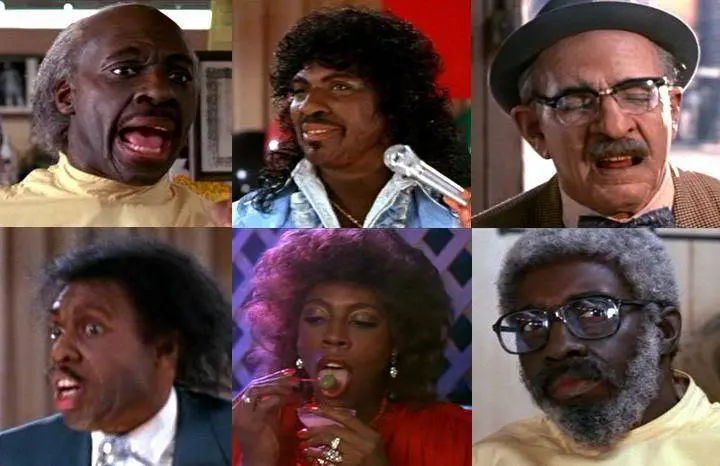
Coming to America was originally titled The Quest.
The real quest may have been to finish the movie in time for its release date. Shooting wrapped only six weeks before it was scheduled to be in theaters and it was in post-production until June 29 - the day before it premiered.
The fact that the movie wasn't DONE may explain why the film didn't screen for critics - speculation was that Paramount didn't think the film was a winner, and apparently there's nothing on paper officially about why the film wasn't shown beforehand. Gene Siskel and Roger Ebert told Oprah Winfrey what they'd heard - that there was one screening for New York critics who trashed it, so Paramount canceled all other critics screenings, saying the picture "wasn't available." Occasionally, unfinished films are shown to the press - so perhaps the truth is in the middle: when New York critics ripped an unfinished film to shreds, they opted to cancel other screenings and therefore, it was unavailable. The producers say withholding the movie from the press was not an intentional decision.
Critics, though, panned the film. The New York Times critic Vincent Canby called the romance "tepid." The Washington Post critic Hal Hinson wrote, "playing a convincing romantic lead may be beyond [Murphy] at this point" and Murphy "aspires to blandness."
Audiences loved the film, and it grossed $288 million worldwide in 1980s dollars. It also put Murphy in the record books: in its first 6 days, Coming to America made $28.4 million, which was the more money than any other non-sequel in history, according to Paramount.
Part of its success was credited to the rom-com angle, which attracted more women to see the movie than Murphy's past films, mostly actioners like 48 Hours and Beverly Hills Cop. Coming to America is the first time Eddie Murphy played a romantic lead.
Eddie Murphy conceived the idea so he could play a different character that didn’t resemble “Eddie Murphy.”
In addition to Akeem, Murphy plays three of the character roles: Clarence, an argumentative barber; Randy Watson, a smarmy fundamentalist soul singer; and Saul, an elderly Jewish man.
Randy Watson's Jheri-curl hair was designed to look like Los Angeles Clipper basketball player Michael Cage.
In addition to Semmi, Arsenio Hall plays Morris from the barbershop, Reverend Brown, and "Extremely Ugly Girl" who seems very attracted to Akeem when he is speed dating.
The third actor in the barbershop quartet is Sweets, played by Clint Smith. Smith was Murphy's best friend from high school. Scriptwriter Bill Blaustein said the characters Murphy and Smith portray was from an act they'd do for fun called "Clinton and Edmond," in which they'd do the barbershop characters, as well as pimps, and entertainment performers. Since Blaustein and Sheffield - who worked with the duo on Trading Places - had heard them do these characters for hours, so they knew they well enough to write it.
Other than the "woman" hitting on Akeem, Murphy and Hall are almost unidentifiable because of the transformative makeup by Hollywood legend Rick Baker. The work nabbed Baker an Academy Award nomination. Director John Landis told Collider how it all came together:
At the time of Coming to America, I had read this article, that I was really offended by, about Jewish comics in blackface – Eddie Cantor and Al Jolson and stuff. I thought it was really ignorant, so I just said, “Eddie, I’m gonna have you play an old Jew”. And he said, “What?” He didn’t believe me, and I said, “Rick Baker can make you an old Jew”. So, we got him in the test makeup, and the test makeup totally convinced Eddie. He had the accent down, [costume designer] Deborah [Nadoolman] made him a hump for his coat, and he went around the Paramount offices flirting with secretaries. He realized, “I can do it”. He was so funny. And what we discovered was that the makeup freed him. Once he was in the makeup, he was just as fresh as when he was nineteen. Once he was in the makeup, he wasn’t Eddie anymore. In fact, the people who made The Nutty Professor said they loved working with Sherman Klump, but they hated working with Eddie Murphy because when he was Sherman, he was a sweet guy. (Laughs)
You know, in Coming to America, there were people who never understood that I didn’t do any optical tricks. It was all straightforward doubles and over-the-shoulders and stuff. So, in Coming to America, there were people who never realized that, at times, Eddie was four of the seven people in the scene because he was so good. So good. And Arsenio [Hall] was really funny in those makeups, too. The preacher was his dad - he was playing his dad! And I loved that great line where he says, “And when Gilligan comes back to the island!”
Bruce McBroom, Murphy's on-set photographer for 16 films, talked to theGrio about Murphy's method process of becoming his side Coming to America characters:
“Once Eddie looked in the mirror and owned this character and inhabited it, he was that way the whole time,” says McBroom. “The day that he came in as the grouchy old white man Saul, with this Yiddish accent from New York, if you bumped into him near craft service, he was an old grouchy white guy. He never breaks character. I’ve been there and heard people say, ‘Oh well, he seems to be in a bad mood.’ I’d say, ‘No, he’s not in a bad mood, he’s playing that man who’s in a bad mood.’
“Eddie doesn’t rehearse and Eddie doesn’t do a lot of takes,” McBroom comments. “He would take the lines, and change them or adlib knowing that the next day he would play the grouchy old white man or the other character. He would then have to think about how to respond to these lines that aren’t in the script that he had ad-libbed the day before. Then you multiply that again by the next day and the third character, and its mindboggling.”
John Amos said one day he was standing outside and another man joins him, dressed in a hoodie, faded jeans and old sneakers. The guy starts asking him questions, saying he'd never heard of him, becoming more and more insulting, and provoking him. Amos finally tells the guy he needs to pack it up and leave. Amos said, "The guy throws his head back and starts to laugh -- that memorable laugh that only Eddie Murphy has, sounds like a mule in heat...ehh ehh ehhh ehhh. He says, 'I got you Amos, I got you!'" It was Murphy, wearing the prosthetic mask of Randy Watson before shooting the Sexual Chocolate scene.
Music supervisor/legend Nile Rodgers says Murphy greeted him on the set one day, dressed as Saul the Barber. He had no idea it was Murphy until he revealed himself - and that people thought Saul must be Murphy's stepfather.
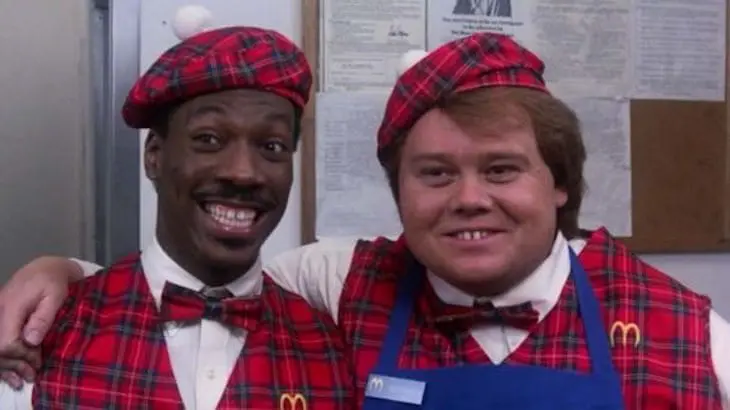
Famous faces in bit or cameo roles: Garcelle Beauvais as a rose bearer, Louie Anderson as a McDowell’s counter server Maurice, Poltergeist/Texas Chainsaw Massacre director Tobe Hooper as a party guest, Samuel L. Jackson as the gunman, “Body by Jake” TV fitness instructor Jake Steinfeld as a cab driver, Vondi Curtis-Hall as the Zamundan arena worker and Cuba Gooding, Jr. in his first on-camera role as “boy getting a haircut.” Additionally, this film launched the career of future “ER” star Eriq La Salle.
Now, Samuel L. Jackson holding a gun and being menacing is well within his acting range. At the time, though, executive producer Mark Lipsky said the new actor hadn't quite mastered it. "John Landis had him do it over and over again. He didn't think Sammy was being threatening enough."
Also garnering a cameo: director John Landis’ signature Easter Egg – the words “See You Next Wednesday.” In Coming to America, it’s a movie poster on a subway station wall – the fictional futuristic sci-fi movie fictionally starred Jamie Lee Curtis and Dan Akyroyd - who had also co-starred in the last Landis-Murphy movie, Trading Places.
The other Easter Egg and cameo is Ralph Bellamy and Don Ameche reprising their roles as Randolph and Mortimer Duke, the characters they played in the Trading Places. Producer George Folsey Jr. said, at the time they just thought it would be cute to make the characters be the bums Akeem hands the bag of money to, "They came in and shot that scene with the two of them underneath the newspapers and in the boxes under the Brooklyn Bridge, where it was like seven degrees," he said. "It turned out to be a really big deal."
About the weather, New York City was a frigid experience. Mark Lipsky, one of Murphy's managers and an executive producer on the film, told GMA, "I remember how cold it was...We had this big space heater giving us some heat. Eddie turned to me and said, 'Do you smell smoke?' My pants were smoldering. I had gotten too close to the space heater."
Model Shari Headley was cast as Akeem’s love interest, which worked because she personally possessed an innocence, confidence, class and life story similar to Lisa McDowell. At 24, she still lived at home and told People Magazine her first kiss came at age 19. “I’m the type who will wait until it’s the right time. I have old-fashioned ideas.” (She even did the interview while babysitting her 3-year-old nephew.)
Headley had small roles on “The Cosby Show” and “Miami Vice,” and had performed in TV commercials for Burger King, Stouffer’s Lean Cuisine and Johnson’s Baby Oil. She had previously "won FORD Modeling Agency’s Supermodel of the Year contest.
John Amos and Madge Sinclair both starred in the miniseries megahit “Roots.” Murphy’s character Saul refers to Akeem as “Kunta Kinte” – Amos’ character in “Roots.”
Amos said he got the call from his agent that John Landis wanted him for the role of Cleo McDowell. Amos said he was in from the point where he heard the character's name and that he owned a McDonald's knock-off. When he met with Landis, the director told him about the engagement party scene where the Jenks SoulGlo family stands up and leaves hair stains on the couch; Amos laughed so hard he fell off his chair and Landis asked if he wanted the role. Amos said, "Try and stop me!"
Amos told Wendy Williams every time he flips stations and finds Coming to America, he watches it. He said he couldn't wait to go to the set every day because, "I'd laugh myself sick every day."
At the time she auditioned to play Lisa McDowell, Garcelle Beauvais was a 19-year-old model who had been in bit parts on "Miami Vice," "The Cosby Show" and "Manhunter." While she didn't get that part, Landis did hire her for the rose bearer role - it was her first feature film.
Almost like a romantic comedy, Eddie Murphy and Arsenio Hall met because originally they didn’t like each other. In a publicity reel for Coming to America, Murphy had declared there were only two black comedians – himself and Richard Pryor. Upon hearing this from a reporter, Hall went into a rant and called Murphy names.
Murphy says he first became aware of Hall when he was flipping channels on the TV and thought he saw himself. He flipped back and realized it wasn’t him, but Hall, and thought he was funny.
Hall says like Semmi, he’s chauvinistic: “it’s a negative quality, I know, but it’s true.” He also said he wouldn’t want to leave Zamunda to move to Queens!
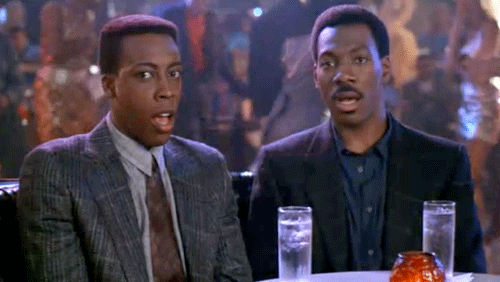
The story is a metaphor for Murphy’s experience once he became an international superstar. The Prince is surrounded by people who do everything for him and worship him because he’s royalty –in America, that’s the equivalent of a wealthy celebrity. The Prince can’t find a woman who he knows will love his true self under those circumstances. Arsenio Hall indicates in the above publicity interview for the studio that Murphy is as sensitive as Semmi, and their stories about finding true friendship and romance are actually “parallel stories.”
Murphy sparked to the story while nursing a broken heart. He and his girlfriend, Lisa Figueroa, began dating when she was a college student at Adelphi University. The reason for the breakup appears to be that she began to own Murphy’s fame as her own, to some degree. Hall told People Magazine, “ “I saw her change under the pressure,” he says. “She began to think she was Eddie. The one person he really loved broke his heart. He was very hurt and down in that period.”
Murphy, therefore, created a movie based on his view of women. The comedian acknowledges that he partook of women throwing themselves at him, similar to the women of Zamunda. But, he craved a woman who appreciated and loved him for who he truly was - not the money, fame and power the woman could absorb by association (like Imani Izizi). Murphy believed women treated him one of two ways: either they dated him for his fame or “go out of their way to show they don’t care who I am that they end up being disrespectful.” Moreover, Murphy did not trust women. He told Rolling Stone the only quality he wanted in a woman was integrity: "I’d take a dumb, honest woman who has nothing on the ball, just honesty. I’d take her every time over a smart one."
Murphy believing he would not be able to find a woman to love him for himself, he told the audience in his concert special Raw that the only way he could ever be sure a woman wasn’t just interested in his money would be to go to Africa and find one sitting “buck naked on a zebra.” So, Coming to America is the same idea, just reversed.
Prince Akeem’s world was built to be a version of Murphy’s life – yes men, insane wealth, women who make themselves available to “service” him, and Arsenio Hall. He doesn't trust any of the women in the land he rules, he lies about his money and position to win the heart of a family-focused honest woman...who happens to be named Lisa.
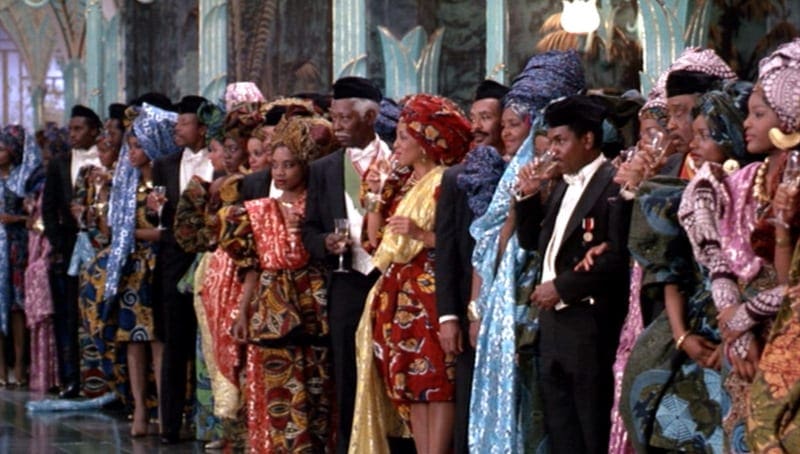
Director John Landis told Bomb Magazine that what he realized he could do with Coming to America is to make what might be seen as a movie for black audiences into a mainstream comedy:
"The thing with Coming to America was it’s silly, it’s a fairy tale. When Eddie pitched me the idea, it wasn’t much of an idea, I realized this is going to be a black movie. I don’t think anyone understands that there will be a couple of white people in it, but essentially it’s an African American movie. But the color had nothing to do with the plot. The plot was purely this love story, fairy-tale, and I realized this is an opportunity to do something really important that nobody will notice. It was the first big Hollywood movie where the character’s skin was not part of the plot—Eddie plays the black guy in Beverly Hills Cop, he plays the black guy in Trading Places. Here, he just plays this guy. It was so successful; no one ever refers to that as an African American movie. Ever. Yet it has three speaking parts for white people. Every other speaking role is an African American."

Eddie Murphy and John Landis had a falling out during the filming of Coming to America. Their stories differ.
Landis told Collider in 2005: The guy on Trading Places was young and full of energy and curious and funny and fresh and great. The guy on Coming to America was the pig of the world – the most unpleasant, arrogant, bulls**t entourage... just an a**hole. However, Eddie is brilliant, and he and I have always worked together well; there’s never been an issue created. On Coming to America, we clashed quite a bit because he was such a pig, he was so rude to people. I was like, “Jesus Christ, Eddie! Who are you?” But I told him, “You can’t be late. If you’re late again, I quit.” We had a good working relationship, but our personal relationship changed because he just felt that he was a superstar and that everyone had to kiss his ass. He was a jerk. But great – in fact, one of the greatest performances he’s ever given. The character he plays in Coming to America, Akeem, is so opposite of what Eddie really was: a gentleman, charming and elegant, as opposed to this jerk-off. Someone, I think it was James Earl Jones, used to say that when Eddie came on set, “It’s like an arctic wind.” (Laughs) I mean, he wouldn’t do his off-camera for people, it was bulls**t. But I still think he’s wonderful in the movie."
The "late" comment coming from Landis is interesting because People Magazine reported this at the time:
According to people on the set, costume designer Deborah Nadoolman—who is also Mrs. John Landis—was reportedly overheard complaining in racial terms one day when Murphy had kept her waiting for more than an hour. When Murphy got wind of it, he was so furious he grabbed Landis by the neck and demanded an apology.
Landis was unavailable for comment, but Murphy doesn’t deny they clashed: “John is a talented director, but we had personal differences. I don’t like him anymore, and he doesn’t like me.”
A year later, Murphy elaborated more to Rolling Stone. Murphy is a committed teetotaler, but he and Arsenio Hall have spoken at length that the argument Murphy and Landis had was so upsetting, it literally drove him to drink:
While making Coming to America, I had some weirdness with John Landis, who was directing the movie. We had a tussling confrontation, and when I went home, Arsenio [Hall] gave me some alcohol to settle me down. I thought a drink might help, so I drank a whole quart of Absolut vodka. I won the Most Vomit Award. I was bent over the toilet for hours. That was the first and last time I’ll ever drink.
The Landis incident has never been clearly explained. One story has it that you two came to blows. What happened?
Nah, we didn’t come to blows. Personalities didn’t mesh. I grabbed him, and he thought I was playing. So he tried to grab my balls, and I pushed him away. But I wasn’t kidding. He was doing some silly shit that made me mad. He directed me in Trading Places when I was just starting out as a kid, but he was still treating me like a kid five year later during Coming to America. And I hired him to direct the movie!
The notion was that you were giving him a nice break at a time when he needed one.
I was gonna direct Coming to America myself, but I knew that Landis had just done three f***ed-up pictures in a row and that his career was hanging by a thread after the Twilight Zone trial. I figured the guy was nice to me when I did Trading Places, so I’d give him a shot. I’m a popular actor in this town, and to have a guy who was as f***ed as he was get a job with me gave him some renewed credibility. I was going out of my way to help this guy, and he f***ed me over. Now he’s got a hit picture on his résumé, a movie that made over $200 million, as opposed to him coming off a couple of f***ed-up movies – which is where I’d rather see him be right now.
The two did resolve the issue. In 2011, Murphy told Rolling Stone:
I had lunch with John about a month ago. We did the ill-fated Beverly Hills Cop III after Coming to America. Yeah, I’m cool with John, I did some great movies with him. Rarely do I have any sh*tiness that stays sh*ty. I either resolve it or walk away. Rarely do I let sh*t linger.
Landis backs that up:
Eddie and I had a real parting of the ways. It was like “F**k you!” We really disliked one another. And many years later, I was approached to do Beverly Hills Cop 3, and I asked, “Well, who’s playing Eddie Murphy?” They said, “No, Eddie asked for you.” So, I met with him, and he was pleasant. I still think it was his way of apologizing, but who knows with Eddie? He’s so strange. A very odd fellow. But so talented.
Murphy talked about what it's like to work with John Landis:
It looks like a bunch of improvisation, but John Landis is on you more than any other director I’ve ever worked with. He’ll tell you how to read the line, and if he wants you to do a physical stunt, he’ll show you. He really gets in there and you’re like, “This motherf**ker.”
By the way...if you want more information on just what happened that night Murphy DID decide to drink, he and Hall reminisced on Hall's syndicated talk show in 2013:
"It was a tough day, tough day of shooting, and I said, 'You need a drink,' because he doesn't drink…and I got him to try vodka and orange juice which is called a screwdriver…," Hall began to explain before Eddie interjected, "Not 'try,' I don't drink. This n---a got me some…he had a fifth of Stolis Vodka and we drank that s--t and the story ended horribly."
Hall continued, "Yeah, but for two hours the party was crazy! It was a house full of people, and at one point, you had a conversation with a dog. A dog named Val. Remember the dog? And you just talked to the dog…"
"I don't remember talking to the dog," Murphy said.
Arsenio explained, "You were on your kitchen floor, and you said, 'Val, I trust you.'"
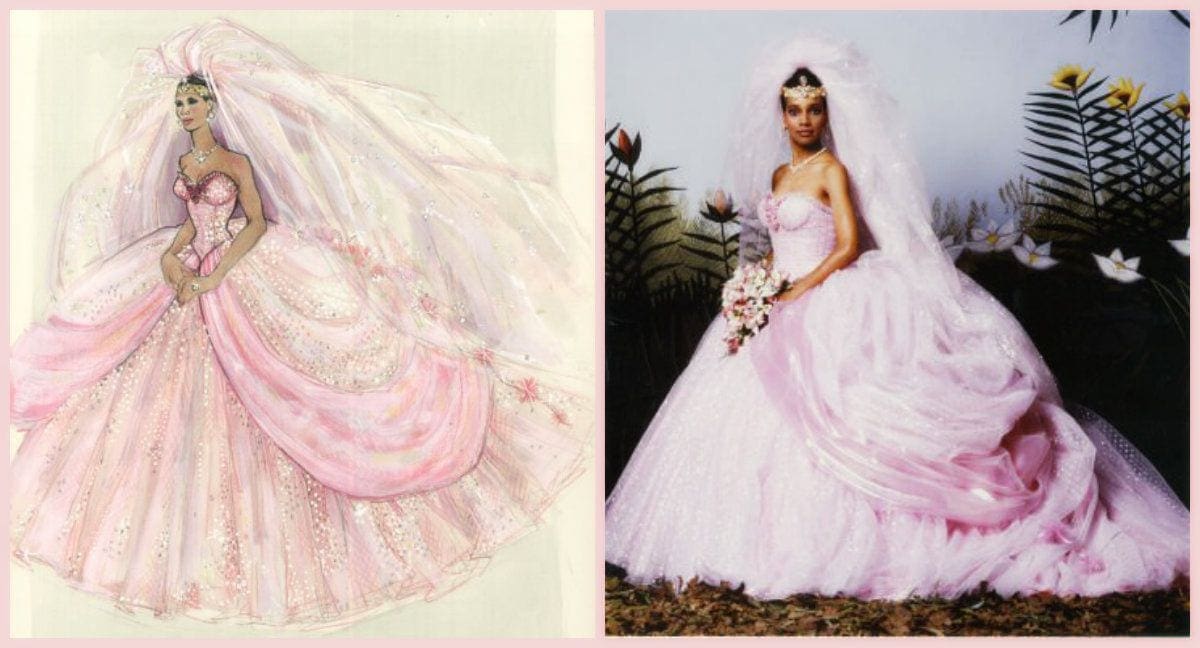
Deborah Nadoolman was nominated for an Academy Award for Costume Design for Coming to America.
What may be surprising is that she is not of African descent, she's a Jewish New Yorker. She's also Mrs. John Landis who was also known for designing Michael Jackson's iconic red jacket. What may be more surprising is that Nadoolman had been studying African dress since college. In an insightful interview with Complex, Nadoolman said:
"And so I had started collecting, from the time I was in college, African arts magazines. So, much later on, after I had designed Coming to America, my friend was like, 'Oh, I see you have African arts magazines—of course you have that, because you designed Coming to America.' I said, 'No, that’s not how it works at all. I had African arts magazines in college.'
"There’s a real North African thing going on between Morocco, Senegal, and Gambia. And then the jewelry on that was gold box jewelry. And you know, all of this was custom-made. James Earl Jones and Eddie Murphy wear this big, brass boxes—you can find Guinean kings who are wearing the exact same thing. All I did was copy them.
"I was familiar…I had already internalized some of African design—east, west, north, south—by the time I had got to Coming to America. I didn’t have time to internalize all that information about all those people in a two-month period. No, no, no. I'd loved that from the time I was young. And so when I was given the dream project, I had a beginning, I had something to think about. I already had knowledge."
She said she'd actually made relationships with African fabric dealers eight years earlier.
"In 1980, John and I were living in London and he was directing and I was designing a movie called An American Werewolf in London. The picture was a contemporary picture, and I designed it, worked on it, but I did have free time in London. And one of my favorite places was Brixton Market. So Brixton was considered very rough in those days. They had—still have—a fabulous, fabulous market. And even within the market I became very friendly with dealers in African fabric."
She said she had purchased many fabrics at the time and had oodles of samples. Those relationships came in handy especially when it came to the Royal Wedding Ball.
"When I had to design that wedding ball, and I wanted to put everyone in those gowns and base those gowns on Gambian and Senegalese dress, I called all of my wonderful market traders at Brixton Market. And they just started sending me samples. I coordinated all the samples, and in came hundreds and hundreds and hundreds of yards of fabric."
The face casts are authentic, the one worn by Oha as a sort of tie/brooch is Nigerian. The ocelot worn by Prince Akeem at the wedding died of natural causes at a zoo (no word on the lion worn by King Jaffe Joffer!).
The Royal Family's jewelry are not props, Nadoolman blew out the budget making everything authentic and that includes working with a jeweler to create the jewelry. She said:
"The jewelry in Coming to America—just the crown—cost $80,000. They were not brass. These were sterling silver-plated, 14 karat gold...And all of those jewels—well, not the diamonds, certainly—the diamonds are not even glass, the diamonds were CZs. I had a 45 karat CZ in James’s crown. So, they’re CZs, they’re real turquoise, they’re real pearls, they’re real hematites, they’re real coral, they’re real citrines. They had real jewels. Because I was not gonna play around."
(Real question: where did all this valuable jewelry end up? Where is it now?)
Nadoolman said she chose the pink wedding dress because she was afraid the white dress next to Murphy's dark complexion would wash her out. She knew Headley had the ability to carry herself in a way that she could carry off all that dress, not that would stop future brides - she said she gets one to three emails a month from brides asking if she can create the same dress for their wedding.
"I always send these young and engaged [women]—I always send them a copy of the original sketch of the dress and that gorgeous portrait of Shari in the dress. And I just say, 'Good luck and God bless.'"
One of Coming to America's most memorable moments is that stunning African dance at the wedding ceremony. Paula Abdul is one of the few choreographers who is a household name, but that wasn't the case when she was given the gig -- her career was just taking off. At the time, she was the head choreographer for the L.A. Laker Girls (the basketball team's cheerleaders) making a name for herself creating the dance moves for Janet Jackson's music videos like "Nasty"and "When I Think of You." She told Rolling Stone why getting the job was so important to her career:
“This was one of my moments of having to really prove myself, because I was still pretty new in my career as a choreographer. John Landis, the director, wanted the person that choreographed Janet Jackson. I was still a Laker Girl. I went in and he looked at me and said, ‘What are you, a teenager?’ And I said, ‘Yes, I am!’ He basically was telling me, ‘What do you know about African dancing?’ And this is my whole thing when becoming a choreographer: ‘I’ll just tell everyone yes, I know exactly what I’m doing, and then I’ll figure it out later.’ That’s basically what I did. I said, ‘I know a lot!’ And he goes, ‘Hmm, I don’t think so, because I was expecting someone like Debbie Allen to come in.’ And I said, ‘I may be young, but I know what I’m doing.’ So he left me alone.
“When you think about it, back then we didn’t have the Internet, so there was no research you could really do, other than going to the library. I created my own style of what I thought should be right for the movie, and John Landis loved it. I worked with Nile Rodgers on the music and we came up with a drum loop. There were lots of intensive rehearsals, and it was hardcore; it was a lot of work. It was not an easy thing to accomplish, but it’s one of the things I’m most proud of.”
The tribal dance scene to mark the introduction of Imani Izzi took two days to film. Garcelle Beauvais, who was the rose bearer standing between Eddie Murphy and Arsenio Hall during the sequence, said to ABC News that she will never forget that dance scene because she had "never seen anything like it. It was a huge production." She said, "John Landis is a perfectionist, and Paula is a perfectionist...It was so huge that it definitely took a long time to get."
Prior to Coming to America, Abdul did choreography for Can't Buy Me Love (1987), Running Man (1987) and Big (1988). Abdul's first single "Forever Your Girl" was released June 21, 1988, one month before Coming to America.
For the tribal dance costumes were a collaboration, costume designer Nadoolman turned to Bob Mackie for help. Mackie was known for working his elaborate gowns with beads, sequins, feathers and which sometimes only covered the key areas but defied any wardrobe malfunctions. Nadoolman said not one of the two dozen dancers lost a single bead off their costumes, which she credits to Mackie's amazing talent.
Oha's song, "She's your Queen to Be" was intended to be sung like an opera, but the filmmakers preferred Paul Bates version better.
During a night shoot, they had a two-hour “1 a.m. lunch break.” Murphy and Hall went to a nearby disco while still in wardrobe “and partied for two hours.” When it was time to go back to the set, Hall says, “We brought company home!” They just brought everyone from the club with them.
McDonald’s was in on the joke. They’d given permission to the film for McDowell’s to be an obvious knockoff of the fast-food behemoth. Still, a nearby McDonald’s didn’t know – they sent a real photographer over (just like in the movie) and the owner threatened to sue the film crew. In reality, "McDowell’s" was a Wendy’s that was about to go out of business. The Wendy’s menu board can be seen in the film. In real life, that Wendy’s-turned-McDowell’s was located on…Queens Boulevard.
During Lisa's speech asking for donations for a local park at the Black Awareness rally, she says, "The children are our future." That line rings familiar from Whitney Houston's 1985 hit, "The Greatest Love of All." It seems that Murphy and Houston, who may have dated in the early '80s, reignited their relationship around the time of Coming to America. In an interview with Sister2Sister, Houston said she was "going with" Eddie at the time she met future husband Bobby Brown at the 1989 Soul Train Awards. However, Murphy has characterized his relationship with late singer as being friends. On another note, Houston also reportedly dated Arsenio Hall, and both have also characterized it as friendship. Wherever the truth lies, it seems the three were definitely good friends.
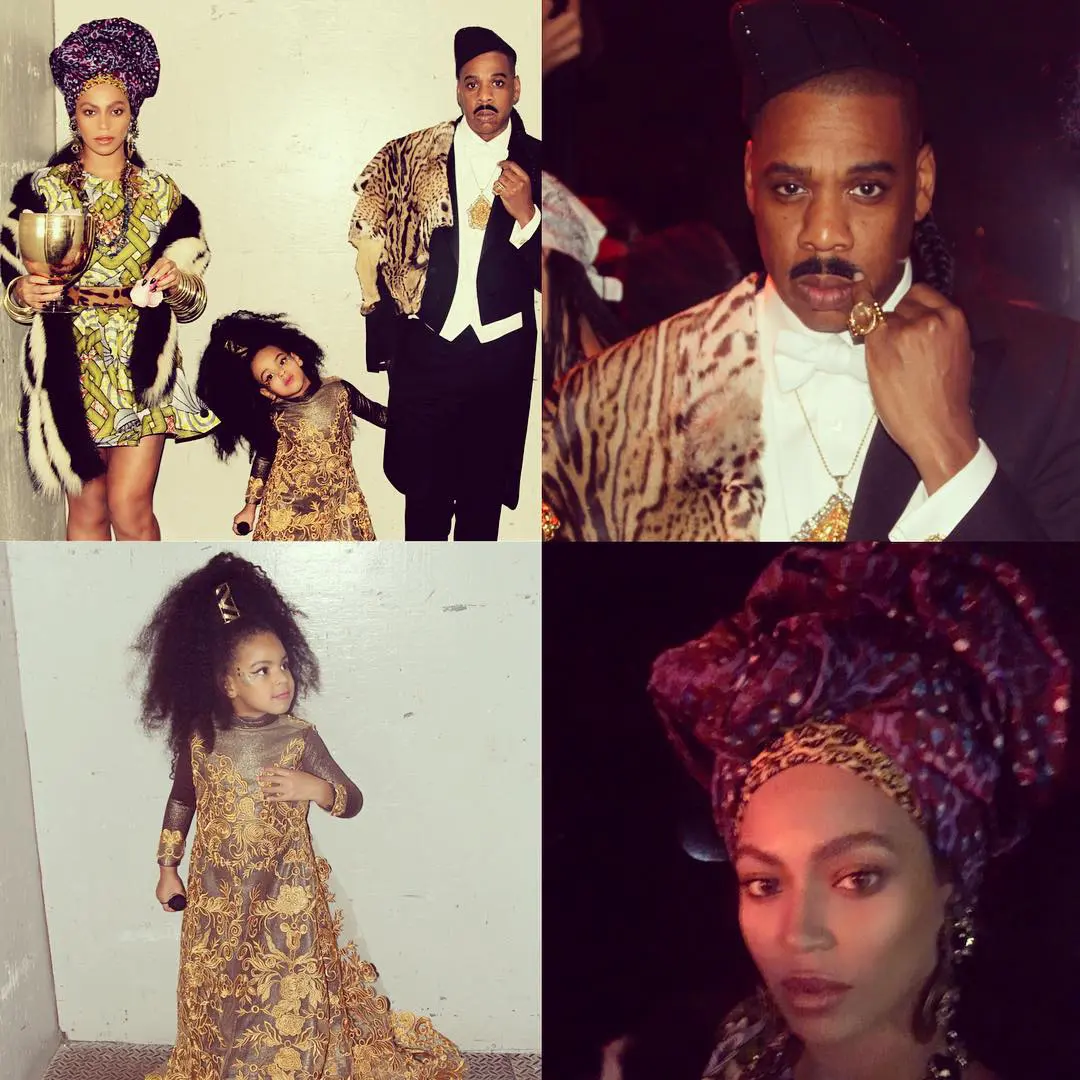
Eddie Murphy and his co-writer David Sheffield says Murphy came up with the concept, writing out his idea on eight to ten pages on a "yellow pad." As outlined above, it's easy to see how Murphy conceived the idea from his broken and angry heart, down to the part where the ideal woman is named Lisa, the name of the woman he had been in love with and whom he'd expected to spend the rest of his life. Robert Wachs, Murphy's manager and the film's co-producer, said Murphy came up with the idea while on a stand-up comedy tour. However, the idea seems to have had some origins in another writer's story - one that had actually been optioned by Paramount for Murphy, specifically.
In 1983, the studio had optioned "King for a Day," a two-and-a-half page outline written by Art Buchwald. Buchwald's idea had a fatal flaw, said Wachs, “Paramount had a story about a king who was a despot, and I told Paramount we weren’t interested in making that movie...We wanted Eddie to be the good guy. To look good. To have morals and ethics and whatnot, and this other thing that was written about a king was not. He was a despot. He was a dictator.”
The court didnt agree. Buchwald's contract with Paramount stated that if the movie were made, he would be paid $65,000 and 1.5 percent of the profits. Additionally, his producing partner Alan Bernheim would be paid $200,000 and 17.5 percent of the profits. Paramount refused to pay because they said the film made no net profits, despite its gross intake of $145,000 (this case is what brought "Hollywood Math" to light, where studios cook the books so it looks like no film makes a profit and, therefore, they don't owe money to those with a backend take or, sometimes, to reimburse producers. Buchwald sued to get paid and the court found in his favor. After four years in court, Buchwald was awarded $150,000 and Bernheim $750,000.
It’s hard to hear James Earl Jones voice while he’s wearing his lion sash and not also hear Mufasa, the patriarchal Lion King. It might seem that Disney casting director Brian Chavanne thought the same. Not only was Jones cast as Simba’s dad, but Madge Sinclair was also cast as Simba’s mom Sarabi … the Lioness Queen.
A TV series was attempted by CBS. “Coming to America” starred Tommy Davidson in his first on-screen acting role as Prince Tariq and Paul Bates reprising his role as Oha. It wasn’t picked up, but did air on “CBS Summer Playhouse” (a summer series that aired the pilot episodes of shows that were not given the greenlight).
Coming to America has had a lasting effect in pop culture, particularly in the black community. Steve Harvey lists it as his favorite movie, it remains a favorite Halloween costume including being worn by The Carter Family –Jay-Z as King Jaffe Joffer, Beyonce as Queen Aoleon and Blue Ivy as Imani Izzi. Additionally, celebrities and others dressed up for the Black Panther premiere in Zamundan attire, celebrating the fictional African royal kingdoms.
A sequel is in the pipeline. Coming to America 2 (working title) will reunite the characters and Murphy, Hall and Amos are all on board. The first film's writers, David Sheffield and Barry Blaustein, wrote the script for the second last summer after having several meetings with Murphy at his house. The screenwriting duo told GMA that "Blackish" writer/producer Kenya Barris is currently doing a second pass (which is common in screenwriting). Jonathan Levine, who helmed Amy Schumer and Goldie Hawn in Snatched, will direct. After years of speculation (and pushing back), Murphy himself was the first to announce the news on his Twitter account in March 2017 with a photo of Imani Izzi; Murphy later said he was hacked and quit Twitter. At the time, Vanessa Bell Calloway said it was the first she'd heard about it and as the writers are being pretty hush hush about what the follow up film will be about, let's hope Imani is not STILL barking like a dog, which is the last place we saw her. Blaustein does give one clue about Cleo McDowell in the next film: "He’s in Zamunda and he opened up a McDowells."
Soundtrack
Nile Rodgers, the Chic guitarist turned music writer-producer, scored Coming to America with songs that combined "African roots with New York City grit." Rodgers calls the score "massively diverse," but many of those songs - like Rodgers' most buzzed about contribution, having Ladysmith Black Mambazo record "Mbube," the SoulGlo commercial and the King's Motorcade - did not make it onto the official soundtrack. The soundtrack had four singles released, "Coming to America" by The System was the first, peaking at No. 23 on Billboard R&B/Hip-Hop Chart (91 on the Hot 100). "Come Into My Life," "Better Late than Never" and "That's The Way It Is" were also released as singles (the Mel & Kim song had been a Top 10 hit in the U.K. before the movie's release). Notice "I Got It" performed by Eddie Murphy is played when Akeem & Semmi enter the nightclub - Murphy had a hit in 1985 with "Party All the Time" and this was from his second album, "Be Happy." Below are all the songs from the film.
Mbube (Wimoweh) by Ladysmith Black Mambazo
"Livin' the Good Life" by Sister Sledge
"To Be Loved" by Jackie Wilson
"Transformation" by Nona Hendryx
"A Wonderful One" by Marvin Gaye & Tammi Terrell
"That's the Way It Is" by Mel and Kim
"Pride and Joy" by Marvin Gaye & Tammi Terrell
"Soul Glo" by Christopher Max
"The King's Motorcade" composed by Nile Rodgers
"Coming to America" by The System
"Ooo Baby Baby" by Smokey Robinson and the Miracles
"I Got It" by Eddie Murphy
"I Like It Like That" by Michael Rodgers
"Comin' Correct" by J.J. Fad
"Come Into My Life" by Laura Branigan and Joe Esposito
"Better Late Than Never" by The Cover Girls
"All Dressed Up (Ready to Hit the Town)" by Chico DeBarge
"Addicted to You" by LeVert
Director: John Landis
Screenwriter: Eddie Murphy, David Sheffield, Barry Blaustein
Release Date: June 29, 1988
Rating: R
Opening Weekend Rank: #1. No other films dared open against a John Landis Eddie Murphy film, but Who Framed Roger Rabbit was #2 film.
Opening Weekend Box Office: $21.4 million
Lifetime Gross: $288.8 million
Budget: $39 million
Production Company: Paramount Pictures
Distributor: Paramount Pictures

